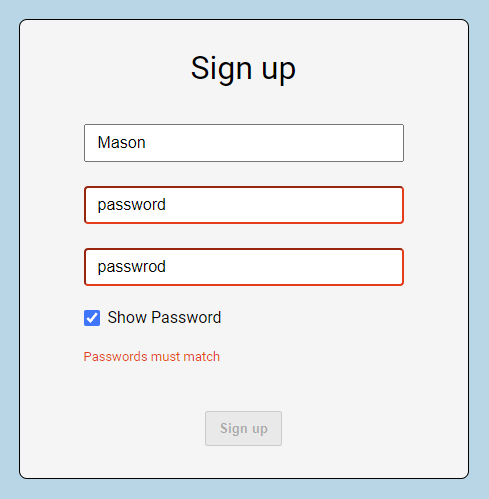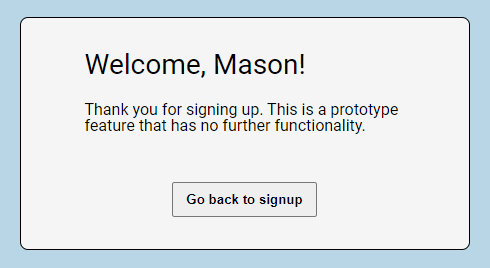This is a prototype Sign up form built using React and JavaScript. This project was part of a coding challenge and is meant to showcase my abilities in using React and JavaScript as a Frontend Engineer.
The form must contain three inputs:
- Username
- Password
- Confirm Password
Each field must persist its own state as the form is filled out. All fields are required with no other restrictions on content. Password and Confirm Password must match in order to submit the form and the user should be alerted if they don't.
I wanted to ensure users are not met with any errors before they have made an attempt to correctly fill out the form. So the form starts in a non-error state until the user has clicked the submit button. Once submitted, all inputs are validated and if they are incorrect the form is then put into an error state which disables the Sign up button and highlights the invalid input fields and surfaces a message that provides details on the error(s) until they are corrected.
I also wanted to ensure users were able to view both password inputs to easily compare them should the two inputs not match. So I added a Show Password checkbox which toggles each password input to a text input, revealing the password(s) in plain text.
Finally, I wanted to add a welcome view once the user has successfully signed up to complete the experience. The username provided in the Sign up form is passed on to this view to add some personalization. However, since there is no further functionality intended for this project, I left a message saying as much as well as a button to return user to the Sign up form in its initial state.
I used the fairly standard way of initializing a React app, Create React App to set up my development environment. I removed a bunch of files that come with CRA initialization that were unnecessary for this scope of project and added a reset.css file (courtesy of meyerweb.com).
Since this project only consists of a single form and welcome view I opted not to use any routing and structured the root component, App.js, to render only the small box which acts as the container for the form and welcome view (I later added social links as a sibling to this box).
For the form inputs, I took the approach of using state tracked by React hooks over using the input DOM element API since I tend to find it more flexible and familiar. This makes it easy and concise to validate the fields using JavaScript within the React component.
Once the form is successfully submitted, I pass the username back to App.ts which stores the value within its own state and switches the Sign up form for the Welcome view, passing the username along to it. When the Go back to sign up button is clicked, it triggers App.ts to delete the stored username, which causes it to switch back to rendering the Sign up form component and the whole process is repeated.


